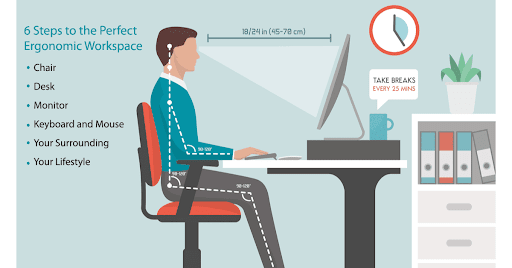
Don’t Let Productivity Suffer Due to Desk Discomfort
How ergonomic are your office chairs, desks, and overall workstation setup? Do your employees experience daily discomfort such as neck strain, back pain, and wrist aches?
Ergonomic workstations are not only great for employee wellbeing but also for business’ performance. They improve productivity by 18% and lean processes by 27%.
Get expert advice to build a healthy workforce.
Has this been happening to your employees lately?
Back/ Neck Pain
Prolonged pain from ergonomic neglect
Eye Strain
Discomfort and fatigue caused by prolonged screen use
Fatigue
General weariness resulting from uncomfortable work setups
Productivity Loss
Uncomfortable setups hinder focus and efficiency
Increased Stress Levels
Ergonomic discomfort amplifies workplace stress
Wrist & Joint Issues
Incorrect heights result in physical strain
Poor Posture
Bad ergonomics contribute to spinal misalignment
Absenteeism
Health issues from poor ergonomics increase absenteeism
What could have caused ergonomic discomfort?
Additionally, prolonged periods of sedentary work without breaks exacerbate physical discomfort. The problem worsens due to lack of knowledge or training on ergonomic principles, since workers may unintentionally adopt behaviors that lead to discomfort and long-term health problems.
The causes of ergonomic discomfort are frequently a confluence of personal habits and workspace design elements. Inadequately built desks, seats, and computer configurations can cause uncomfortable postures that can result in musculoskeletal pain. Incorrect monitor arrangement and inadequate lighting can cause eye strain and tiredness.
How Should a Perfect Workstation Be?

Physiotherapy for a Healthy Workforce
Physiotherapy is essential for improving ergonomic health and reducing stress in the workplace.
Physiotherapists use a range of methods to build a healthier workforce.
| Team Assessments | Group Exercise | Workshop Sessions |
| Physiotherapists do assessments for whole teams to find shared ergonomic problems and areas of improvement | Customized group exercise programs meet the goals of the team as a whole, improving health and addressing concerns that everyone shares | Physiotherapists teach teams about good balance, ways to deal with stress, and how important it is to move around regularly at work during the day |
| Ergonomic Education | Stress Management | Injury Prevention |
| Help teams understand ergonomic principles better by giving them advice on how to make the best use of their shared office | Physiotherapists lead workshops on methods for reducing stress, giving teams useful ways to deal with stress at work | Physiotherapists work with teams to develop prevention strategies, reducing the risk of musculoskeletal issues |
| Team Building through Wellness | ||
| Physiotherapy helps build teams by supporting overall health, which makes the workplace healthier and more cohesive | ||
FAQs related to Workplace Ergonomics
How can ergonomic assessments benefit our employees’ health and productivity?
Ergonomic assessments can identify and address potential sources of discomfort, reducing the risk of musculoskeletal issues. This, in turn, enhances employee well-being, leading to increased productivity and job satisfaction.
What common musculoskeletal issues can arise from poor workplace ergonomics?
Poor ergonomics can contribute to issues such as back pain, neck strain, and repetitive strain injuries, affecting employees’ physical health and overall work performance.
How can ergonomic assessments benefit our employees’ health and productivity?
Ergonomic assessments can identify and address potential sources of discomfort, reducing the risk of musculoskeletal issues. This, in turn, enhances employee well-being, leading to increased productivity and job satisfaction.
Can you provide customized exercises to address specific ergonomic challenges faced by our employees?
Absolutely. Tailored exercise programs target specific ergonomic concerns, helping employees strengthen core muscles, improve posture, and prevent or alleviate discomfort associated with their work environment.
What are the key elements of an ergonomic workstation setup, and how can our employees implement them?
An ergonomic workstation should include proper chair and desk heights, adequate lighting, and well-placed computer equipment. Employees can implement these changes with guidance on optimal adjustments for their individual needs.
How can physiotherapy contribute to stress reduction and improved posture in the workplace?
Physiotherapy employs techniques such as manual therapy, exercise programs, and stress management strategies to alleviate physical discomfort, reduce stress levels, and enhance overall posture for a healthier work environment.
What role does regular movement and stretching play in maintaining good ergonomics at work?
Regular movement and stretching break the cycle of prolonged sitting, promoting blood circulation, flexibility, and muscle engagement. These practices are crucial for preventing stiffness and maintaining optimal ergonomic conditions.
How can our employees balance the demands of desk work with the need for physical activity during the workday?
Encouraging short breaks for stretching or brief exercises, incorporating standing workstations, and promoting walking meetings are effective strategies to strike a balance between desk work and physical activity, enhancing both productivity and well-being.
Do you offer group workshops or training sessions on ergonomic principles for our entire team?
Yes, group workshops are available to educate your team on ergonomic principles, providing practical tips for optimizing workstations, promoting good posture, and fostering a healthier work environment.
Can physiotherapy interventions help prevent and manage common workplace injuries among our employees?
Absolutely. Physiotherapy interventions include injury prevention strategies, addressing ergonomic concerns, and providing personalized plans to manage and alleviate discomfort, reducing the risk of workplace injuries.






